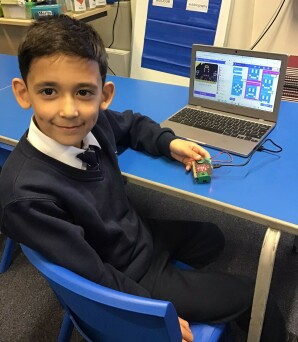Computing
 At St. Mary’s we believe that computing is a vital skill that empowers our students to think critically, solve problems, and express their creativity. Our goal is to provide a comprehensive computing curriculum that caters to all learners, fostering a passion for technology and its applications in everyday life. In school, we use the Teach Computing curriculum to deliver modern and relevant lessons suitable to prepare children to understand computing and keep them safe online.
At St. Mary’s we believe that computing is a vital skill that empowers our students to think critically, solve problems, and express their creativity. Our goal is to provide a comprehensive computing curriculum that caters to all learners, fostering a passion for technology and its applications in everyday life. In school, we use the Teach Computing curriculum to deliver modern and relevant lessons suitable to prepare children to understand computing and keep them safe online.
Aims
The aims of our computing curriculum are to ensure that all students:
- Develop a secure understanding of the principles of computer science.
- Gain proficiency in using technology to create, communicate, and collaborate.
- Understand the importance of online safety and the ethical use of technology.
- Become resilient problem solvers who can design, code, and evaluate algorithms.
- Apply their computational thinking in real-life scenarios.
Curriculum Overview
As outlined in the 2014 National Curriculum for Computing, our curriculum comprises three key areas:
Computer Science
- Understand and apply the fundamental principles of computer science, including logic, algorithms, and decomposition.
- Use programming languages to create and debug algorithms.
- Recognise the impact of computer science on individuals, society, and the economy.
Information Technology
- Use technology to manipulate data and create effective presentations and digital products.
- Develop the skills to retrieve, store, and manage information using appropriate software and tools.
- Collaborate using technology for shared tasks and projects.
Digital Literacy
- Understand the importance of being safe and responsible online.
- Develop skills to navigate and evaluate online content critically.
- Promote effective communication and digital citizenship.
Teaching and Learning Strategies
We employ a range of teaching and learning strategies to ensure inclusivity and engagement in computing lessons. These strategies include:
- Differentiated tasks that cater to various ability levels.
- Collaborative projects that promote teamwork and peer learning.
- Practical lessons that utilise a range of software and hardware.
- Integration of cross-curricular themes that allow application of computing concepts in other subjects.
- Use of assessment for learning to inform teaching and provide feedback to pupils.
Online Safety
At St. Mary’s, we prioritise the safety and well-being of our pupils in their use of technology. We ensure:
- Regular teaching of online safety curriculum tailored to age and understanding.
- Parental engagement through workshops and resources on keeping children safe online.
- Regular updates for staff on best practices and legal responsibilities regarding online safety.
